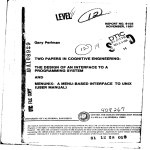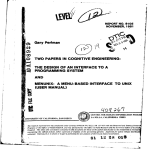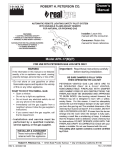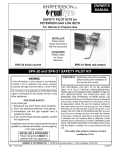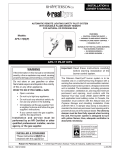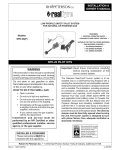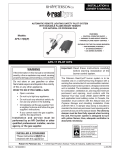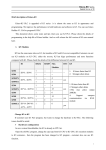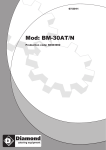Download R.H. Peterson G4 Owner`s manual
Transcript
Robert H. Peterson Company LOW PROFILE SAFETY PILOT KIT Owner’s Manual For Natural or Propane Gas INSTALLER: Please leave these instructions with the consumer. CONSUMER: Please retain for future reference. MODEL #SPK-26 Important: WARNING If the information in this manual is not followed exactly, a fire or explosion may result, causing property damage, personal injury, or loss of life. - Do not store or use gasoline or other flammable vapors and liquids in the vicinity of this or any other appliance. WHAT TO DO IF YOU SMELL GAS: • Open a window. • Do not try to light any appliance. • Do not touch any electrical switch; do not use any phone in the building. • Immediately call the gas supplier from a neighbor’s phone. Follow the gas supplier’s instructions. • If you cannot reach the gas supplier, call the fire department. - Installation and service must be performed by a qualified professional installer, service agency, or the gas supplier. INSTALLER & CONSUMER These instructions MUST be retained with this appliance. Read these instructions carefully before starting the installation of the burner and control. BE SURE THE FIREPLACE DAMPER IS FULLY OPEN WHEN OPERATING THE BURNER THE PETERSON BURNER IS TO BE BURNED ONLY IN A FULLY VENTED, NONCOMBUSTIBLE FIREPLACE WITH DAMPER AND CHIMNEY FREE OF ANY OBSTRUCTIONS. THE FIREPLACE MUST BE DESIGNED AND APPROVED TO BURN WOOD. Like burning natural firewood, the Peterson burner is designed to burn with a yellow, smoky flame. For this reason, it must be adequately vented. Be sure the fireplace damper is fully open when you burn the gas burner. The smallest dimension of the chimney flue must be at least 8". If it is smaller, DO NOT USE A PETERSON BURNER. If fumes from the burner emerge into the room when the damper is fully open, creating a smell like a smoldering oil lamp, it indicates that the fireplace draft is defective. Check chimney flue for obstructions. DO NOT OPERATE LOGS UNTIL THE FIREPLACE DRAFT IS CORRECTED. Check with the dealer or installer. Do not use firewood with this unit. This safety pilot system contains a control certified by C.S.A. Robert H. Peterson Co. • 14724 East Proctor Avenue • City of Industry, California 91746 REV 1 - 0711091249 1 No. L-A2-08107 IMPORTANT INFORMATION CHECK TO BE SURE THAT THE SAFETY PILOT HAS BEEN ASSEMBLED FOR THE PROPER GAS. (Reference FOR PROPANE GAS section on the next page.) The installation, including provisions for combustion and ventilation air, must conform with local codes, or, in the absence of local codes, with the National Fuel Gas Code, ANSI Z223.1 (latest edition). This appliance must be isolated from the gas supply piping system by closing its individual manual shutoff valve during any testing of the gas supply system at test pressures up to and including 1/2 psig. This appliance and its individual shutoff valve must be disconnected from the gas supply piping system when testing at pressures that exceed 1/2 psig. This is accomplished by closing the gas supply line valve. WHEN GLASS FIREPLACE ENCLOSURES (DOORS) ARE USED, OPERATE THE GAS BURNER WITH THE GLASS DOORS OPEN; BOTH SIDES IF FIREPLACE IS SEE-THRU TYPE. PARTS LIST To gas supply 9 2 Supplied with the burner kit CK-4 7 10 8 Pilot gas supply line To nipple Thermocouple lead 3 Fig. 2-1 TO LO PI 5 0F 4 F N Gas inlet nipple 6 1 Item No. 1. 2. or 3. 4. 5. 6. Part No. SV-19 PAC-1NAT PAC-1LP HS-32 KNOB-6 EH-2 SH-1 REV 1 - 0711091249 Description Safety control valve Natural pilot assembly Propane pilot assembly Heat shield SPK-26 knob Extension handle Flame diverter bracket Item No. 7. 8. 9. or 10. or 2 Part No. PB-1 GP-1 PBO-20 PBO-10 PT-1NAT PT-1LP Description Pilot mounting bracket Pilot assembly insulation pad Natural gas orifice Propane gas orifice Nat. pilot/thermocouple assy. w/leads LP pilot/thermocouple assy. w/leads No. L-A2-08107 HOW TO ASSEMBLE THE SAFETY PILOT KIT This safety pilot kit must be installed by a qualified professional installer. Instructions must be followed carefully when installing to ensure proper performance and full benefit from the gas burner and safety pilot kit. These instructions must be used as a supplement to the instructions supplied with the Peterson gas burner. Follow the gas burner instructions and make adjustments as appropriate for the addition of a safety pilot kit. Use gas pipe sealing compound that is resistant to all gasses, or Teflon tape, and apply to all male pipe connections. Make sure that all connections are tight. CAUTION: Do not cover the safety pilot valve with sand or lava granules, as it may cause overheating. FOR PROPANE GAS Note: Heat shield is not shown, but must be in place when operating the burner. The safety pilot kit is shipped with a natural gas orifice installed unless the safety pilot kit was received in the same box as the propane burner. To change from natural to propane gas, remove the pilot gas supply line at the pilot end. Replace the natural gas orifice with the propane gas orifice (Item 9, Fig. 2-1) contained in the envelope marked "L.P.-GAS". Reattach the pilot gas supply line to the pilot. SPK valve Fuel injector/ air mixer STEP 1: CONNECTING THE SAFETY VALVE Fig. 3-1 A. Remove the heat shield, knob, and handle extension. STEP 2: INSTALLING THE FLAME DIVERTER BRACKET B. Apply gas pipe compound or Teflon tape to the fuel injector/air mixer pipe threads. Be careful not to block the opening of the fuel injector/air mixer. Purpose: The flame diverter bracket, when properly installed onto Peterson G4, GX4, VG4, and P series burner pans equipped with a safety control system, will promote quicker ignition of the Peterson gas burner and protect the safety control system from overheating. C. Screw the safety valve (Item No. 1) to the fuel injector or air mixer on the burner (Fig. 3-1). Be sure that the valve is positioned parallel with the fireplace floor. FOR LEFT-SIDED INSTALLATION: A. Install the flame diverter bracket before installing the pilot assembly. A. Make sure the fuel injector and burner cap are reversed so the fuel injector is on the left side of the burner and the cap is on the right. B. Place flame diverter bracket (Item 6) over the side edge of the burner pan where the Peterson safety control system pilot bracket (Item 7) will be attached. The bracket should be placed approximately 1 1/4" from the back of the burner pan (see Fig. 3-2 or fig. 3-2C for left-sided installation). B. Flip the SPK-26 safety valve over so the opening is to the right, and then mirror the illustration in Fig. 3-1. CAUTION: Be careful not to kink the pilot supply tube or thermocouple. C. Tap the bracket lightly with a hammer to secure it in place. Fig. 3-2 a. b. c. Pilot assembly 1 Flame diverter bracket Left-sided installation example Pilot assembly Pilot assembly 1/ 4" Burner pipe Mounting bracket Insulation pad Pilot bracket Insulation pad Burner pipe Flame diverter bracket Flame diverter bracket Burner pan Burner pan REV 1 - 0711091249 3 No. L-A2-08107 HOW TO ASSEMBLE THE SAFETY PILOT KIT (Cont.) CAUTION: CAUTION: Do not get granules into the pilot burner. Do not kink the pilot supply tube or thermocouple. STEP 3: INSTALL THE PILOT ASSEMBLY TO THE BURNER Refer to the PARTS LIST when following these instructions. GLOWING EMBER - G4, GX4, & VG4 SERIES FLAME PAN - P SERIES (PROPANE) Pilot assembly Pilot assembly Flame diverter bracket Mounting bracket Insulation pad Mounting bracket Insulation pad Burner pan Flame diverter bracket Burner pan A. Attach the mounting bracket with the screws provided (Item 7) to the pilot assembly as located above. A. Attach the mounting bracket to the pilot assembly with the screws provided (Item 7). Note: Bracket and pilot assembly are shown attached in above illustration. Note: B. Carefully bend the thermocouple lead and the pilot gas supply line (Item 10) so the pilot assembly is positioned as illustrated above. Bracket and pilot assembly are shown attached in above illustration. B. Carefully bend the thermocouple lead and the pilot gas supply line (Item 10) so the pilot assembly is positioned at end of the pan as illustrated. C. Place the insulating pad (Item 8) between the bracket and the pan. Insert the screws through the pilot bracket (Item 7) and the holes in end of the pan. C. Place the insulating pad (Item 8) between the bracket and the pan. Insert the screws through the pilot bracket (Item 7) and the holes in end of pan. STEP 4: ATTACHING THE HEAT SHIELD TO THE SAFETY CONTROL VALVE A. The heat shield is designed to protect the valve, knob, and extension handle in both right and left-sided installations (see Fig. 4-1 and 4-2 below). MIDDLE KEY SLOT Middle key HOLE hole slot L 0FF PILOT ON B. Place the heat shield on the valve with the middle key hole slot resting on the extension handle. Slide the heat shield back so the middle key hole slot locks onto the valve collar (where the extension handle attaches to the valve) and the rear slot fits over the back of the valve (see Fig. 4-3). Fig. 4-3 Fig. 4-1 Fig. 4-2 Installation of SPK on right-hand-side of the burner Installation of SPK on left-hand-side of the burner L L TOLIP ON ON REV 1 - 0711091249 4 PILOT 0FF FF0 No. L-A2-08107 SPK-26 OPERATING INSTRUCTIONS * We recommend that before you install the burner you familiarize yourself with the control valve layout. This will help you to be confident operating the burner when fully installed (see figures below for typical control positions). HOW TO LIGHT THE PILOT Read here To light the pilot from the PILOT position (Fig. 5-2), push in slightly on the knob and turn to the OFF position (Fig. 5-1). Wait five minutes, then turn the knob to the PILOT position (Fig. 5-2). Push the knob fully in and at the same time place a long lighted match or long necked lighter at the pilot burner. The pilot should light. Hold the knob in approximately 60 seconds. If the pilot does not stay lit, turn to the full OFF position (Fig. 5-1). Wait five minutes and repeat the LIGHTING INSTRUCTIONS. HOW TO TURN THE GAS BURNER ON AND OFF USING THE SAFETY PILOT KIT 1. Use OFF only when complete shutdown is necessary. Fig. 5-1 OFF position Burner off - pilot off Read here 2. Turn dial to PILOT position. With match ready, press knob in and hold for 60 seconds while lighting pilot. BE SURE THE DAMPER IS FULLY OPEN WHEN OPERATING THE GAS BURNER. TO TURN ON THE GAS BURNER FROM THE PILOT POSITION: When the pilot is lit (Fig. 5-2), turn the knob 90° counter-clockwise to the ON position (Fig. 5-3). TO TURN OFF THE GAS BURNER FROM THE ON POSITION (Fig. 5-3): Turn the knob 90° clockwise to the PILOT position (Fig. 5-2). Fig. 5-2 PILOT position Burner off pilot on Read here TO TURN OFF THE GAS BURNER AND THE PILOT FROM THE PILOT POSITION (Fig. 5-2): Push in slightly on the knob and turn 90° clockwise to the OFF position (Fig. 5-1). 3. Turn knob to ON to light burner. Fig. 5-3 ON position Burner on pilot on Example of burner pilot flame FOR IMPROVED PILOT OPERATION PILOT ADJUSTMENT Pilot adjustment Should the pilot require adjustment, the following steps should be taken: With the pilot lit and the control knob in the pilot position, use a long narrow screw driver and turn the pilot adjustment screw slowly clockwise to reduce the pilot flame or counter-clockwise to increase the flame (Fig. 5-4). The adjustment screw can be turned so that the pilot flame is completely extinguished. Some tightening of the screw may occur during adjustment; this is normal. The pilot flame should be a soft blue color with slightly yellow tipping which encircles the thermocouple tip. Turn the control knob to the ON position to assure proper ignition of the log burner. REV 1 - 0711091249 5 Fig. 5-4 No. L-A2-08107 TROUBLESHOOTING THE SPK-26 SAFETY PILOT KIT PROBLEM 1. Pilot will not light CAUSE SOLUTION a. Obstruction in pilot gas supply/ pilot gas supply line is kinked a. Clear out obstruction. Replace pilot gas supply line if kinked b. Inadequate gas supply c. Pilot out of adjustment b. Have gas pressure checked by installer or gas supplier d. Air in line c. Adjust pilot (see page 5) d. Air should clear, attempt to relight 2. Pilot will not stay lit after releasing knob a. Pilot flame out of adjustment (tip of the flame should encircle tip of the thermocouple) a. Adjust pilot (see page 5) b. Thermocouple (SPK) either too tight or too loose c. Replace thermocouple b. Thermocouple should be finger tight and then 1/8" turn with a wrench c. Bad thermocouple 3. Burner extinguishes a few minutes after lighting. a. Inadequate gas supply causes pilot flame to reduce after burner lights a. Using pilot adjustment, increase gas to pilot. Pilot flame must be in contact with the thermocouple tip 4. Burner extinguishes after burning for some time (approximately 10 minutes to 1 hour) a. Thermocouple has overheated; glass doors are closed a. Be sure glass doors are open during operation b. Thermocouple has overheated; insulation pad is not in place b. Be sure that the insulation pad is in place between the burner pan and the pilot bracket c. Thermocouple has overheated; burner flames are heating the thermocouple cold junction 5. Pilot will light without holding in knob or gas flows to burner without pilot being lit a. Valve is installed backward c. Be sure the pilot assembly and the flame diverter are in their proper position. Rearrange logs so that flame is not deflected to the thermocouple a. Reinstall valve with inlet por t attached to gas supply and outlet port attached to burner If you still experience problems with the SPK-26 safety pilot kit, please contact a local Peterson dealer. REV 1 - 0711091249 6 No. L-A2-08107 This page intentionally left blank. 7 WARRANTY PETERSON VENTED GAS LOG SETS LIMITED WARRANTY All Peterson gas logs are WARRANTED for as long as you own them (lifetime). All Peterson burner assemblies are WARRANTED for TEN (10) YEARS. SPK-26 controls are covered by a THREE (3) YEAR “All Parts” Warranty. All other Peterson valves, pilots, and controls are covered by a ONE (1) YEAR Limited Warranty (excluding batteries). PLEASE KEEP A COPY OF YOUR SALES SLIP FOR PROOF OF PURCHASE This warranty applies to the original purchaser and to single family residential use only. It commences from date of purchase, and is valid only with proof of purchase. This warranty does not cover parts becoming defective through misuse, accidental damage, electrical damage, improper handling, storage, and/or installation. Product must be installed (and gas must be connected) as specified in the instructions or operator’s manual, by a qualified professional installer. Accessories, parts, valves, remotes, etc., when used must be Peterson Co. product. This warranty does not apply to rust, corrosion, oxidation, or discoloration, unless the affected component becomes inoperable. It does not cover labor or labor-related charges. This warranty specifically excludes liability for indirect, incidental, or consequential damages. Some states do not allow the exclusion or limitation of incidental or consequential damages, so the above exclusion may not apply to you. This warranty gives you specified legal rights, and you may have other rights that may vary from state to state. For additional information regarding this warranty, or to place a warranty claim, contact the R.H. Peterson dealer where the product was purchased. ROBERT H. PETERSON CO. Quality Check Date:___________ Orifice # (Main):__________ Orifice # (Other):__________ Leak Test: ___________ Burn Test: ___________ Gas Type: NAT. / PROPANE Model #: ___________ Serial #: ___________ Air Shutter: ___________ Inspector: ___________ Robert H. Peterson Co. • 14724 East Proctor Avenue • City of Industry, CA 91746 8








